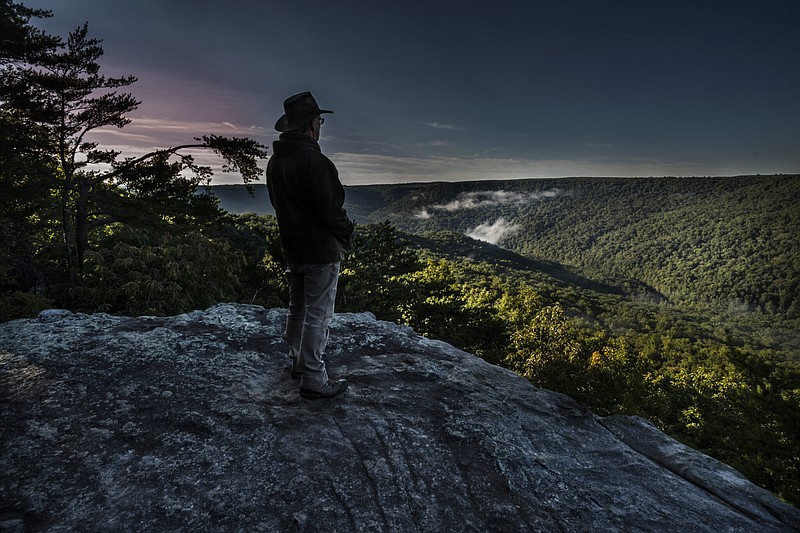Tennessee Wildlife Resources Agency officials have formally released details of a plan for the clearing of thousands of acres of forest in a popular, publicly-owned hunting and recreation destination in White County.
About 2,000 acres in the Bridgestone Firestone Centennial Wilderness Area in White County - about halfway between Nashville and Knoxville - will be cleared in phases over the next three years to create a grassy habitat for the Northern bobwhite quail, a game bird whose population has plummeted in Tennessee in recent decades.
A bidding process for timber companies to purchase the rights to harvest trees begins next month, according to the wildlife agency plan unveiled at a regular board meeting in December.
The agency's public unveiling of the plan has galvanized local officials in opposition to clearcutting an area that has long served as an unspoiled wilderness - and an economic boon to local businesses catering to tourists, hikers, kayakers and other visitors who stay in local vacation rentals, visit local coffee shops and fill up their cars at local gas stations.
The White County Board of Commissioners on Dec. 20 voted unanimously in favor of a resolution urging state officials and elected representatives to "stop the cutting."
And in a December letter to Gov. Bill Lee, White County Executive Denny Robinson laid out their reasons:
"When the Bridgestone land was gifted to the state in 1998 both citizens and leadership were led to believe that the property would remain as wilderness," Robinson wrote. "When land is transferred to the state, counties lose their ability to leverage property taxes. We strive to make up the difference through tourist-driven sales tax.
"TWRA's plan will degrade the entrance to our county's best tourist attraction, and it is in stark contrast to the preservation promised to the citizens in the '90s and contradicts Tennessee's September 2021 announcement of their intent to 'leverage state lands for tourism in rural and distressed counties.'"
The land was deeded to the state by the Nashville-based Bridgestone Corp. with certain strings attached, including its maintenance as a wilderness area. The Tennessee Wildlife Federation was appointed a third-party caretaker, to ensure the state complied with the conditions of the gift. In early December, Tennessee Wildlife Federation officials said they had concluded TWRA's plan met those conditions since its goal was to create "essential habitat for many species across Tennessee."
White County officials, environmental groups and local hunters, however, have pointed to other adjacent areas for potential habitat that would not involve cutting hardwood trees.
"TWRA maintains that the effort is to create quail habitat," Robinson, the county executive, said. "If quail habitat is the goal, there are thousands of acres available to accomplish this without clearcutting the heart of the area."
(READ MORE: Clearcutting plans in state wilderness area get legal approval despite local opposition)
Plans for clearcutting in the Bridgestone Firestone Centennial Wilderness Area were first leaked last summer in the form of an internal Tennessee Wildlife Resources Agency map that showed 2,000 acres marked for deforestation in White County - in an area adjacent to Fall Creek Falls State Park and Virgin Falls State Natural Area - in order to establish habitat for the Northern bobwhite quail, the official game bird of Tennessee, which thrives in savannas with sparse tree canopies.
The leaked map quickly circulated among local hunters, hikers and civic leaders in White County, who expressed outrage that an unspoiled wilderness that has stood for generations, even before it was gifted to the state, was being slated for cutting without public input or notice.
In a hastily called public meeting in October, wildlife resources officials described the leaked map as a conceptual map inadvertently distributed on a field trip with members of Quail Forever, a quail restoration group geared primarily toward small game bird hunters.
The wildlife agency displayed a new map to the standing-room-only attendees at the public meeting that outlined plans to clear 230 acres in its first phase of quail habitat restoration. Officials at the time did not elaborate on whether more acres would be cut.
The latest Tennessee Wildlife Resources Agency map, like the leaked map, shows a little more than 2,000 acres are slated for harvesting in the wilderness area.
(READ MORE: Tennessee Gov. Lee opens new $40.3 million Lodge Fall Creek Falls)
About 5% of all land in Tennessee is owned or managed by the wildlife agency.
"If we're going to have any positive impact on wildlife, we have to do everything we can to manage that habitat to the benefit of multiple wildlife species in the land we have under our control," Brandon Wear, Tennessee Wildlife Resources Agency's Regional Wildlife Program manager, said in releasing the agency's plans.
Read more at TennesseeLookout.com.
